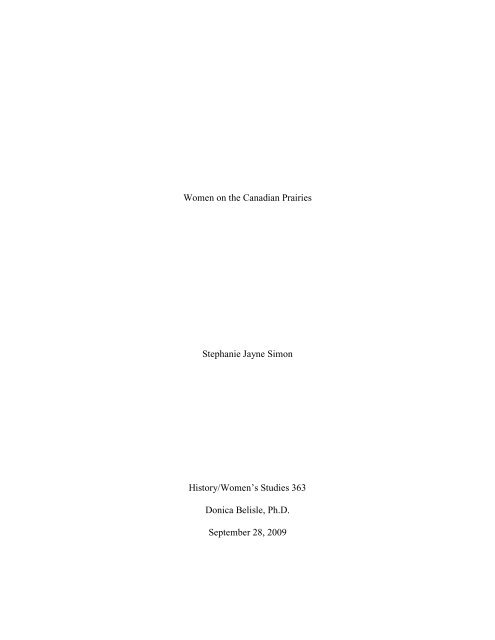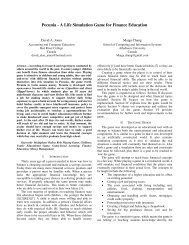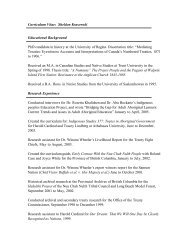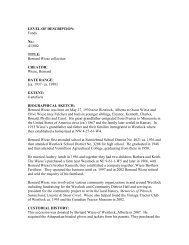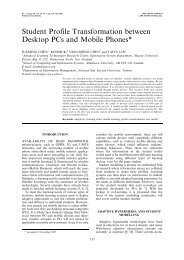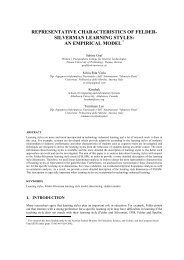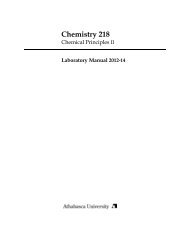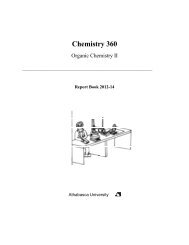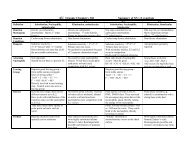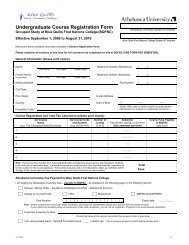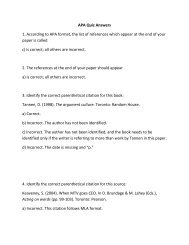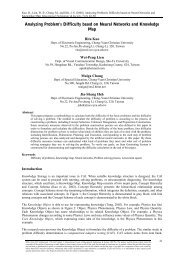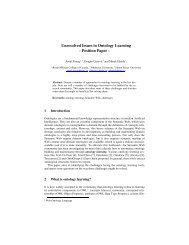Childbirth and Maternal Practices in Canada from - The Alberta ...
Childbirth and Maternal Practices in Canada from - The Alberta ...
Childbirth and Maternal Practices in Canada from - The Alberta ...
Create successful ePaper yourself
Turn your PDF publications into a flip-book with our unique Google optimized e-Paper software.
Women on the Canadian Prairies<br />
Stephanie Jayne Simon<br />
History/Women‟s Studies 363<br />
Donica Belisle, Ph.D.<br />
September 28, 2009
2<br />
<strong>The</strong> purpose of this paper is to study the lives of women <strong>in</strong> the late eighteen<br />
hundreds to early n<strong>in</strong>eteen hundreds liv<strong>in</strong>g on the Canadian prairies. First-h<strong>and</strong> accounts<br />
that document the day-to-day experiences of pioneer women will be used to provide<br />
<strong>in</strong>sight <strong>in</strong>to how these women responded to their new environment, dealt with the trials<br />
<strong>and</strong> tribulations they encountered, <strong>and</strong> resolved the psychological <strong>and</strong> physical emotions<br />
their experiences evoked. Pioneer women faced many obstacles <strong>in</strong> the new l<strong>and</strong>, but<br />
showed themselves to be resourceful people <strong>and</strong> good partners to their husb<strong>and</strong>s. Pioneer<br />
women shared the workload on the homestead. <strong>The</strong>y endured many hardships such as<br />
poverty, lonel<strong>in</strong>ess, sickness, <strong>and</strong> danger, <strong>in</strong> most cases overcom<strong>in</strong>g all obstacles. At<br />
times they took full responsibility for the homestead, family <strong>and</strong> livestock. As they<br />
worked through these difficult years they began to see that though they contributed<br />
equally to whatever venture husb<strong>and</strong> <strong>and</strong> wife were <strong>in</strong>volved <strong>in</strong>, they were not considered<br />
equals <strong>in</strong> either culture or law. With that realization pioneer women took on a new task<br />
fight<strong>in</strong>g for <strong>and</strong> achiev<strong>in</strong>g equal rights for women.<br />
Primary sources used are taken <strong>from</strong> the follow<strong>in</strong>g writ<strong>in</strong>gs: <strong>The</strong> Silence of the<br />
North by Olive A. Fredrickson who lived predom<strong>in</strong>ately <strong>in</strong> northern <strong>Alberta</strong> s<strong>in</strong>ce<br />
childhood <strong>in</strong> 1910; Gully Farm by Mary Hiemstra who came to Saskatchewan as a child<br />
with her parents <strong>in</strong> 1903; It Could Have Been Worse by Peggy Holmes who <strong>in</strong> the 1920‟s<br />
lived <strong>in</strong> St. L<strong>in</strong>a, <strong>Alberta</strong> with her husb<strong>and</strong>; Women <strong>and</strong> Wheat by Georg<strong>in</strong>a B<strong>in</strong>nie-Clark<br />
who struggled to build up a farm for herself dur<strong>in</strong>g 1905-08, <strong>and</strong> <strong>The</strong> Pioneer Years<br />
1895-1914: Memories of Settlers Who Opened the West by Barry Broadfoot, which is a<br />
collection of stories by pioneers who rem<strong>in</strong>isce about the past. <strong>The</strong>se women shared the<br />
responsibilities <strong>and</strong> work load of settl<strong>in</strong>g the l<strong>and</strong> on the prairies alongside of the men.
3<br />
<strong>The</strong>y endured the hardships <strong>and</strong> struggles when there was little <strong>in</strong>come <strong>and</strong> a lack of<br />
resources to keep the family alive <strong>and</strong> the homestead go<strong>in</strong>g. <strong>The</strong>se women were<br />
determ<strong>in</strong>ed to overcome the challenges by work<strong>in</strong>g hard, help<strong>in</strong>g the men, <strong>and</strong> build<strong>in</strong>g a<br />
community. Stories <strong>from</strong> the primary sources tell about personal accounts <strong>from</strong> women<br />
that endured hardships of settl<strong>in</strong>g the l<strong>and</strong>. <strong>The</strong>se <strong>in</strong>clude liv<strong>in</strong>g <strong>in</strong> log cab<strong>in</strong>s, surviv<strong>in</strong>g<br />
the cold <strong>and</strong> harsh w<strong>in</strong>ters, defend<strong>in</strong>g the homestead <strong>from</strong> prairies fires, <strong>and</strong> the<br />
lonel<strong>in</strong>ess that came with isolation <strong>from</strong> other women. Other hardships <strong>and</strong> struggles for<br />
these women were when the men had gone <strong>from</strong> home, <strong>and</strong> the women were left to keep<br />
the homestead, their children, <strong>and</strong> the house on their own. This <strong>in</strong>creased the women‟s<br />
responsibilities <strong>and</strong> work load s<strong>in</strong>ce she had the task of car<strong>in</strong>g for the homestead as well<br />
as her household chores. <strong>The</strong>se personal accounts are evidence that women shared<br />
equally with the men <strong>in</strong> the duties of build<strong>in</strong>g a home for their families, <strong>and</strong> they were<br />
equal partners with their husb<strong>and</strong>s on the homestead.<br />
Com<strong>in</strong>g to <strong>Canada</strong> <strong>and</strong> Homestead<strong>in</strong>g: A New Life for Emigrant Women<br />
To get an idea of what life was like for pioneer women it is necessary to look at<br />
the phenomenon called homestead<strong>in</strong>g. Homestead<strong>in</strong>g was a phenomenon of the late<br />
eighteen hundreds to early n<strong>in</strong>eteen hundreds, <strong>in</strong> which emigrants were lured to the<br />
Canadian prairies by government advertisements of "free" l<strong>and</strong>. Under the Dom<strong>in</strong>ion<br />
L<strong>and</strong> Policy, 160 acres cost $10 for the homesteader who with<strong>in</strong> three years could<br />
cultivate a m<strong>in</strong>imum of 40 acres <strong>and</strong> erect a permanent dwell<strong>in</strong>g; usually constructed<br />
<strong>from</strong> trees or sod. i To meet this requirement the homesteader needed to acquire oxen <strong>and</strong><br />
implements to till <strong>and</strong> harvest the l<strong>and</strong>. A homesteader would also need <strong>in</strong>come to help<br />
develop his l<strong>and</strong> <strong>and</strong> often worked on the railroad until his farm began produc<strong>in</strong>g. ii
4<br />
Work<strong>in</strong>g on the railroad took the homesteader away <strong>from</strong> his family, <strong>and</strong> he would have<br />
to leave his l<strong>and</strong> for long periods of time; this meant that many of the tasks fell to the<br />
wife.<br />
Many of the families who came were not aware of the difficulties they would<br />
encounter because of promoters like Mr. Barr, who pa<strong>in</strong>ted a glorious picture of the<br />
opportunities that homestead<strong>in</strong>g had to offer. An example of this is Mary Hiemstra‟s<br />
family who came <strong>from</strong> Engl<strong>and</strong> to <strong>Canada</strong> on March 31, 1903 to the Barr Colony <strong>in</strong><br />
Saskatchewan. In Engl<strong>and</strong> her father had a farm, but he was not satisfied with the small<br />
plot of l<strong>and</strong>. A man <strong>from</strong> Manitoba came to tell those who would listen about what<br />
<strong>Canada</strong> had to offer <strong>and</strong> Hiemstra‟s father liked what he had to say. “If we had a bigger<br />
farm we could have a horse-drawn rake… they say even the small fields <strong>in</strong> <strong>Canada</strong> are a<br />
half mile long.” iii he told his wife. It all sounded good to him. Hiemstra‟s mother on the<br />
other h<strong>and</strong> was very skeptical of the stories told by this Manitoba man <strong>and</strong> what was<br />
pr<strong>in</strong>ted <strong>in</strong> the paper. It said l<strong>and</strong> was free <strong>in</strong> <strong>Canada</strong>, but Hiemstra‟s mother thought<br />
“Papers don‟t seem to care what they pr<strong>in</strong>t these days” <strong>and</strong> “You can‟t believe all you<br />
hear, <strong>and</strong> only half you see.” iv When the decision came to go to <strong>Canada</strong>, Hiemstra‟s<br />
mother was repeatedly encouraged by her family to say <strong>in</strong> Engl<strong>and</strong> <strong>and</strong> let Hiemstra‟s<br />
father go by himself. Hiemstra‟s mother agreed with them say<strong>in</strong>g, “…that man <strong>from</strong><br />
Manitoba told me a few th<strong>in</strong>gs. <strong>The</strong>re aren‟t any penny trees even on the prairies”. v<br />
However, her commitment to her husb<strong>and</strong> was strong even though she did not believe the<br />
promises of <strong>Canada</strong>.<br />
Once the Hiemstra‟s, along with other emigrants, arrived on <strong>Canada</strong>‟s east coast,<br />
they had a long journey across the country to the prairies; when they got off the ship, they
5<br />
traveled by tra<strong>in</strong>. When the railway came to the “end of the steel,” as they would say,<br />
emigrants got off there <strong>and</strong> traveled on down the trails out west by wagon pulled by oxen<br />
or horses. Distances travelled by emigrants were far greater lengths than they could<br />
imag<strong>in</strong>e, <strong>and</strong> it was slow go<strong>in</strong>g with a wagon full of supplies, especially if it was pulled<br />
by oxen. Supplies were needed to get started on the prairies <strong>and</strong> were obta<strong>in</strong>ed at the<br />
stores <strong>in</strong> town. A team of horses or oxen <strong>and</strong> a wagon was acquired at the livery barns.<br />
Those who did not have the money to pay <strong>in</strong> advance could keep credit with the owner.<br />
Many emigrants that came <strong>from</strong> Europe had been trades people <strong>and</strong> did not know<br />
anyth<strong>in</strong>g about farm<strong>in</strong>g. Even if they did farm, they were not aware of what they needed<br />
to survive on the prairies. Dur<strong>in</strong>g the first ten years of homestead<strong>in</strong>g there was no<br />
economic substructure that a pioneer could rely on. vi Communities were not fully<br />
established, so there were few towns or country stores, <strong>and</strong> so pioneers had to produce<br />
food <strong>from</strong> the l<strong>and</strong>. This was hard for them as they were not well acqua<strong>in</strong>ted with the<br />
conditions of prairie soil <strong>and</strong> climate. vii Many of the immigrants had no experience <strong>in</strong><br />
farm<strong>in</strong>g either, but fortunately, there were often people who had come to <strong>Canada</strong> earlier<br />
who were will<strong>in</strong>g to help the new pioneers.<br />
It was the man <strong>in</strong> the hardware store who helped us… [Wrote Hiemstra]. <strong>The</strong> man<br />
said buy three axes. Dad, I remember, said one would be enough. No the man said,<br />
what if you break one <strong>and</strong> lose another <strong>and</strong> then where are you. Without an axe,<br />
you are noth<strong>in</strong>g… “What about a team” Of course Dad hadn‟t thought of that <strong>and</strong><br />
here was everybody gett<strong>in</strong>g off the tra<strong>in</strong>s, every day, <strong>and</strong> buy<strong>in</strong>g horses <strong>and</strong> we‟d<br />
been camped just on the edge of town for four days <strong>and</strong> Dad hadn‟t done a th<strong>in</strong>g<br />
about gett<strong>in</strong>g there. viii<br />
Hiemstra‟s family left Saskatoon for Battleford by wagon pulled by horses. Travel for<br />
them was much slower than her father expected; the prairies far wider than he thought<br />
they would be, <strong>and</strong> the Hiemstra‟s had a low supply of food before they got far. Dur<strong>in</strong>g<br />
their travel they came across an old-timer who suggested leav<strong>in</strong>g Hiemstra‟s mother <strong>and</strong>
6<br />
her sibl<strong>in</strong>gs on the prairies <strong>and</strong> her father go<strong>in</strong>g back with an empty wagon to get more<br />
supplies, or they would never make it to Battleford. Leav<strong>in</strong>g the mother <strong>and</strong> children<br />
alone on the prairies was not the last time that would happen, as life on the homestead<br />
proved soon enough. This was a totally new experience for Hiemstra‟s mother s<strong>in</strong>ce “he<br />
[Hiemstra‟s father] <strong>and</strong> Mother had never been apart for more than a night now <strong>and</strong> then<br />
ever s<strong>in</strong>ce they were married, <strong>and</strong> leav<strong>in</strong>g her alone with three small children <strong>in</strong> what she<br />
called the middle of nowhere wasn‟t easy.” ix<br />
Hiemstra‟s mother was now start<strong>in</strong>g a new life on the prairies as a pioneer<br />
woman, <strong>and</strong> start<strong>in</strong>g <strong>in</strong> a most difficult way; alone on the bare prairie. <strong>The</strong> daily tasks<br />
Hiemstra‟s mother completed on that trail while her husb<strong>and</strong> left for supplies was a trend<br />
many homestead women would do <strong>from</strong> now on. Some of the tasks that Hiemstra‟s<br />
mother <strong>and</strong> other prairie women had to carry out were haul<strong>in</strong>g water <strong>from</strong> the slough,<br />
stra<strong>in</strong><strong>in</strong>g out the pond critters to make tea, bannock, <strong>and</strong> wash clothes; milk<strong>in</strong>g the cow,<br />
<strong>and</strong> br<strong>in</strong>g<strong>in</strong>g her to the slough to get water; haul<strong>in</strong>g wood to build <strong>and</strong> start a fire to cook<br />
<strong>and</strong> keep warm. From the beg<strong>in</strong>n<strong>in</strong>g pioneer<strong>in</strong>g required hard work by both men <strong>and</strong><br />
women.<br />
Resourceful Pioneer Women Helped to Construct Hous<strong>in</strong>g<br />
Build<strong>in</strong>g a shelter on the homestead was a priority. Liv<strong>in</strong>g <strong>in</strong> a tent was not an<br />
ideal situation once the Canadian w<strong>in</strong>ter came with its freez<strong>in</strong>g temperatures <strong>and</strong><br />
blizzards that kept one <strong>in</strong>doors for days. Houses were constructed <strong>from</strong> trees if bush was<br />
available, <strong>and</strong> if not, plow<strong>in</strong>g the prairie l<strong>and</strong> made sod for stack<strong>in</strong>g. Women worked<br />
right alongside of the men to plough the rough prairie grasses <strong>and</strong> gather the sod. <strong>The</strong>se<br />
women helped carry heavy pieces of sod <strong>and</strong> stack them grass side down <strong>in</strong> double rows
7<br />
to make the walls of their new homes, x <strong>and</strong> these sod homes were small, dark <strong>and</strong> had<br />
leaky roofs, but the women turned them <strong>in</strong>to cozy homes. Many women covered the<br />
walls of their sod homes with paper or cloth <strong>and</strong> others plastered them with clay <strong>and</strong><br />
straw. Some log <strong>and</strong> sod houses had w<strong>in</strong>dows <strong>and</strong> were divided <strong>in</strong>to rooms with lumber<br />
or curta<strong>in</strong>s. Leaky roofs came with the ra<strong>in</strong> <strong>and</strong> created work for the women to keep the<br />
house dry. Besides all of this, many times these women performed this hard manual labor<br />
while pregnant <strong>and</strong> still nurs<strong>in</strong>g the last baby that had arrived months earlier. Still, these<br />
women cont<strong>in</strong>ued on, kept homes, raised their children <strong>and</strong> worked side by side with their<br />
husb<strong>and</strong>s <strong>in</strong> the fields. For the homestead to be established “all the muscle power of men<br />
<strong>and</strong> women as well as that of oxen or horses was needed.” xi Both men <strong>and</strong> women were<br />
expected to work together till the work was done. After all the hard work the results were<br />
not always what the women expected. Hiemstra‟s father told her mother how he was<br />
go<strong>in</strong>g to build a cab<strong>in</strong> on the edge of the grove at the far corner of the quarter section. Her<br />
response showed her disappo<strong>in</strong>tment <strong>in</strong> the size of the cab<strong>in</strong> by remark<strong>in</strong>g that it was the<br />
size of a h<strong>and</strong>kerchief <strong>and</strong> no bigger than a doll house. Hiemstra‟s mother appeared to<br />
long for her home <strong>in</strong> Engl<strong>and</strong> with her <strong>in</strong>ability to see the size of the cab<strong>in</strong> as be<strong>in</strong>g<br />
sufficient. Hiemstra‟s father did his best to enlarge the size of the cab<strong>in</strong> even though tall<br />
poplars were hard to f<strong>in</strong>d. Once the walls were erected the task of putt<strong>in</strong>g a roof on<br />
consisted of Hiemstra‟s father plough<strong>in</strong>g several furrows <strong>in</strong>to foot-long pieces, pil<strong>in</strong>g<br />
them <strong>in</strong>to the wagon <strong>and</strong> haul<strong>in</strong>g them to the house. With Hiemstra‟s father on the roof<br />
<strong>and</strong> Hiemstra‟s mother on the ground, she would h<strong>and</strong> the sod up to her husb<strong>and</strong>. “It was<br />
hard, dirty work, <strong>and</strong> to get it over with as soon as possible Mother <strong>and</strong> Dad worked all<br />
day long, then, black <strong>and</strong> hungry, we got <strong>in</strong>to the dirty wagon <strong>and</strong> went home.” xii With all
8<br />
this hard work by pioneers, it did not enter their thoughts while build<strong>in</strong>g their homes that<br />
the challenges of mak<strong>in</strong>g a suitable home would not end. Later that w<strong>in</strong>ter Hiemstra's<br />
family would f<strong>in</strong>d the log cab<strong>in</strong> to be very cold; this was due to the green trees they used<br />
to build her home. This common problem for pioneers was resolved by fill<strong>in</strong>g<br />
the cracks with more mud. Hiemstra‟s mother was often pessimistic when Hiemstra‟s<br />
father proposed ideas to make life on the prairies better. At first, she would try to<br />
discourage him <strong>from</strong> go<strong>in</strong>g through with his ideas, but <strong>in</strong> the end, she supported her<br />
husb<strong>and</strong> <strong>and</strong> did her best to help make the project succeed.<br />
Many of the pioneer women learned to work along with their husb<strong>and</strong>s utiliz<strong>in</strong>g<br />
whatever resources they had to make a suitable place to live. In the early 1920‟s, Olive<br />
Fredrickson with her first husb<strong>and</strong> Walter Reamer went <strong>in</strong>to the Northwest Territories for<br />
the w<strong>in</strong>ter to trap game for <strong>in</strong>come. S<strong>in</strong>ce Fredrickson had to help construct the log cab<strong>in</strong>,<br />
she needed to be resourceful out <strong>in</strong> the wilderness, <strong>and</strong> f<strong>in</strong>d a safe place for her baby. She<br />
used a hammock she had received <strong>from</strong> an Indian woman <strong>in</strong> Fort Fitzgerald <strong>and</strong> hung it<br />
between two trees <strong>and</strong> covered it with a mosquito net. “Walter cut <strong>and</strong> notched the trees,<br />
<strong>and</strong> together we carried them up to the site <strong>and</strong> rolled them <strong>in</strong>to place.” xiii It took two<br />
weeks to build the cab<strong>in</strong>; it had a w<strong>in</strong>dow, a door hung, <strong>and</strong> a bunk bed. Fredrickson cut<br />
hay with a butcher knife to make a mattress <strong>and</strong> built cupboards out of wooden pack<strong>in</strong>g<br />
crates. One drawback of their cab<strong>in</strong> was that big spruce beetles came out of the spruce<br />
logs when the stove heated the cab<strong>in</strong> because the bark had been left on. Even though<br />
Fredrickson did not always have the best liv<strong>in</strong>g environment, she helped put a roof over<br />
their heads, <strong>and</strong> made do with the resources that were available.
9<br />
On the other h<strong>and</strong>, Peggy Holmes <strong>and</strong> her husb<strong>and</strong> had better resources to<br />
construct their home <strong>and</strong> together were able to build a good house for their family.<br />
Holmes went to <strong>Canada</strong> with her husb<strong>and</strong>; they headed to northern <strong>Alberta</strong> to live <strong>in</strong> the<br />
bush at St. L<strong>in</strong>a. Here they planned the build<strong>in</strong>g of their new home “the Gables”. “We<br />
both agreed that our log house had to be a home, not just a low build<strong>in</strong>g with a sod roof<br />
like most others. It must have two storeys with gables – custom built on a do-it-yourself<br />
basis.” xiv Logs for the build<strong>in</strong>g of the home were done by “snak<strong>in</strong>g” out tamarack <strong>from</strong><br />
the bush with the team of horses <strong>and</strong> taken to a small saw mill a few miles away. This<br />
lumber was sawed so it could provide boards for the floors, doors, <strong>and</strong> f<strong>in</strong>ish<strong>in</strong>g jobs.<br />
Together Holmes <strong>and</strong> her husb<strong>and</strong> constructed the gable home by 1922. <strong>The</strong> three<br />
pioneer women, Hiemstra‟s mother, Holmes, <strong>and</strong> Fredrickson, are good examples of the<br />
different situations many pioneer women found themselves <strong>in</strong>, as immigrants to this new<br />
country. Some had better resources than others, but they all had to work hard, <strong>and</strong> help<br />
their husb<strong>and</strong>s provide a home for their families to live.<br />
Pioneer Women Learn to Survive the Chang<strong>in</strong>g Seasons on the Prairies<br />
Prairie Fires<br />
Changes came with the end of summer <strong>and</strong> start of fall: birds flew south for the<br />
w<strong>in</strong>ter, rabbits turned white to match the snow, <strong>and</strong> the trees lost their leaves <strong>and</strong> the<br />
grass became dry <strong>and</strong> crisp-smell<strong>in</strong>g. This was also a time for prairie fires, <strong>and</strong> many<br />
immigrants had heard frighten<strong>in</strong>g stories. When they came, they came fast with w<strong>in</strong>d, <strong>and</strong><br />
no one had time to run. If they came at night people could easily die <strong>in</strong> their beds; burned<br />
to death or smothered by the smoke. “„Be sure you have everyth<strong>in</strong>g ready,‟ the old-timers<br />
warned. „Some sacks with hay <strong>in</strong> the bottom to give them weight, <strong>and</strong> a barrel of water to
10<br />
wet the sacks <strong>in</strong>.‟” xv Plow<strong>in</strong>g a fire guard was another way settlers could help keep fire<br />
away <strong>from</strong> their barns <strong>and</strong> houses, that is if the fire did not jump the plowed furrows of<br />
dirt.<br />
Prairie fires were a threat to the pioneers, not only because of the risk of los<strong>in</strong>g<br />
their valuables, but also because they came unexpectedly. <strong>The</strong> few items that pioneers did<br />
receive were accumulated through work<strong>in</strong>g hard, <strong>and</strong> were very valuable, s<strong>in</strong>ce these<br />
items were often difficult to come by. Women shared equally with their husb<strong>and</strong>s <strong>in</strong> the<br />
care <strong>and</strong> protection of the farm. Hiemstra writes that her mother said if a fire came she<br />
would run away, <strong>and</strong> she didn‟t sleep well at night because she worried about a prairie<br />
fire com<strong>in</strong>g. When the fire did come, they saw a puff of yellow cloud <strong>in</strong> the distance<br />
beh<strong>in</strong>d the trees <strong>and</strong> it grew bigger. Her father immediately hooked the team up to the<br />
plow to make a wider fire guard, <strong>and</strong> her mother ran to the barn to get the sacks. <strong>The</strong>y<br />
also started a back-fire to burn aga<strong>in</strong>st the approach<strong>in</strong>g prairie fire to protect their<br />
homestead. Hiemstra‟s mother had outdone herself, <strong>and</strong> stood by her husb<strong>and</strong> <strong>in</strong> the fight<br />
to defend the farm. When the fire had passed <strong>and</strong> neighbors gathered together, the men<br />
praised the women for their vigorous efforts to beat the fire back with sacks. <strong>The</strong> women<br />
just did what they had to do to keep the little they had <strong>from</strong> be<strong>in</strong>g lost. Hiemstra‟s father<br />
said about his wife that “…she thought she wasn‟t pioneer stuff.‟ „And I‟m not,‟ Mother<br />
said firmly. „And I‟d rather be where there are no prairies fires to fight.‟ ” xvi<br />
Other pioneer women experienced the same fears Hiemstra‟s mother did.<br />
However, when the farm <strong>and</strong> family were threatened, they put their fears beh<strong>in</strong>d them,<br />
determ<strong>in</strong>ed to survive whatever challenges the chang<strong>in</strong>g prairie season brought. One<br />
account <strong>in</strong> <strong>The</strong> Pioneer Years 1895-1914 tells of one day that the men were gone, <strong>and</strong>
11<br />
Mother was home alone when she saw smoke <strong>in</strong> the distance. With the pails of water<br />
ready, <strong>and</strong> sacks to dip <strong>in</strong> them, Mother was ready for the fire when it got close to the<br />
house. “…she fought it <strong>and</strong> fought it until she was exhausted. But she managed to protect<br />
a little bit of the l<strong>and</strong> right around our shack <strong>and</strong> a bit of the thick grass where our horses<br />
could graze.” xvii Many pioneers looked forward to the w<strong>in</strong>ter months, hop<strong>in</strong>g this would<br />
end the prairie fires, but the chang<strong>in</strong>g seasons brought other problems.<br />
Long Cold W<strong>in</strong>ters <strong>and</strong> Heavy Snow Fall<br />
On the farm th<strong>in</strong>gs needed to be done to prepare for the com<strong>in</strong>g w<strong>in</strong>ter, <strong>and</strong> many<br />
old-timers would warn the immigrants of temperatures reach<strong>in</strong>g m<strong>in</strong>us forty to fifty<br />
degrees Celsius. <strong>The</strong>y told them to make sure there was enough firewood cut for fuel, <strong>and</strong><br />
to get warm clothes to wear for the w<strong>in</strong>ter. <strong>The</strong> start of w<strong>in</strong>ter with its dropp<strong>in</strong>g<br />
temperatures <strong>and</strong> <strong>in</strong>creased snow fall caused many Barr colonists to leave the homestead<br />
to stay <strong>in</strong> town. Hiemstra writes that “the cold that had driven many of the Barr colonists<br />
to Lloydm<strong>in</strong>ster was bad enough, we thought, but it wasn‟t long before it got much<br />
worse. <strong>The</strong> thermometer went down to fifteen below zero, <strong>and</strong> more snow fell.” xviii It was<br />
not just the cold <strong>and</strong> snow blizzards that would threaten life, but the length that w<strong>in</strong>ter<br />
weather could last. “But nobody told us how cold it was <strong>and</strong> how long the w<strong>in</strong>ter lasted,”<br />
Hiemstra wrote. xix When the w<strong>in</strong>ter was long, food supplies could become a problem if<br />
there was not enough to hold families over until spr<strong>in</strong>g f<strong>in</strong>ally came. xx<br />
Aga<strong>in</strong> the pioneer women would prove to be resourceful <strong>and</strong> determ<strong>in</strong>ed to<br />
survive the unpredictable chang<strong>in</strong>g seasons of the prairies. As with the prairie fires<br />
pioneer women had to protect their families. <strong>The</strong>y had to make the food supplies stretch<br />
out as long as the w<strong>in</strong>ter did when spr<strong>in</strong>g did not arrive when expected. <strong>The</strong>y also cared
12<br />
for the home <strong>and</strong> children when their husb<strong>and</strong>s left to buy more supplies. In the book<br />
Gully Farm, Hiemstra‟s father went to get food <strong>and</strong> supplies <strong>from</strong> Battleford with the<br />
neighbor, while her mother was left at home alone with the children. Hiemstra‟s father<br />
had sawed a large pile of firewood that he thought would hold out till he got back, but his<br />
supply had dw<strong>in</strong>dled surpris<strong>in</strong>gly fast. Hiemstra‟s mother went to saw more logs with the<br />
cross-cut saw, but <strong>in</strong> the cold her h<strong>and</strong>s <strong>and</strong> feet became numb, <strong>and</strong> her breath<strong>in</strong>g<br />
difficult. “We‟ll have to saw some wood <strong>in</strong> the house‟ she said at last.” xxi Dragg<strong>in</strong>g logs<br />
<strong>in</strong>to the house Hiemstra <strong>and</strong> her mother tried saw<strong>in</strong>g the logs, but the teeth stuck halfway<br />
through the log <strong>and</strong> they could not move it. Hiemstra‟s mother showed her despair when<br />
little sister Lily said “I‟se told” <strong>and</strong> trembled <strong>in</strong> a huddled corner of the wagon bench, a<br />
helpless little figure. “„This awful country,‟ Hiemstra‟s mother said <strong>in</strong> a despair<strong>in</strong>g voice.<br />
„I allus knew it was only bid<strong>in</strong>g its time. My bairns will freeze‟.” xxii To save her children<br />
<strong>from</strong> the silent cold of the deadly w<strong>in</strong>ter, Hiemstra‟s mother shoved the end of the uncut<br />
piece of wood <strong>in</strong>to the stove. As it burned down her mother would push the log further<br />
<strong>in</strong>to the stove. Not only was keep<strong>in</strong>g a fire go<strong>in</strong>g a problem, but the food was almost<br />
gone. <strong>The</strong> t<strong>in</strong> box for tea was empty, the coyotes stole the rabbits hang<strong>in</strong>g outside, <strong>and</strong><br />
Hiemstra‟s mother was not able to snare any more. It was the last of the bak<strong>in</strong>g powder<br />
<strong>and</strong> to ensure it lasted her mother made flour gruel twice a day <strong>in</strong>stead of bannock. <strong>The</strong><br />
whole episode was a rem<strong>in</strong>der of her dislike for this country which she believed was<br />
look<strong>in</strong>g to end their lives, <strong>and</strong> she would rem<strong>in</strong>d Hiemstra‟s father of her dislike for this<br />
country <strong>and</strong> how she longed for Engl<strong>and</strong>.
13<br />
Another record of an unhappy pioneer woman was that of a young lady who came<br />
to <strong>Canada</strong> to stay with her brother Dan <strong>in</strong> 1905 <strong>in</strong> Saskatchewan. She wrote her family <strong>in</strong><br />
Engl<strong>and</strong> stat<strong>in</strong>g her condition:<br />
In about two months a letter came back <strong>from</strong> Florrie. <strong>The</strong>re were dried tear marks<br />
on the pages. She said it was terrible. Just terrible. We couldn‟t imag<strong>in</strong>e how<br />
terrible it was. <strong>The</strong> weather was cold, terribly cold, <strong>and</strong> where they lived was not a<br />
house but a log shack <strong>and</strong> she drew a diagram to show how small it was. She said<br />
they ate porridge <strong>and</strong> rabbits <strong>and</strong> the only comfort was tea <strong>and</strong> sugar. <strong>The</strong> nearest<br />
neighbor was five miles away. And on <strong>and</strong> on. xxiii<br />
Lonel<strong>in</strong>ess on the Prairies<br />
Distances between homesteads made regular visits to neighbors difficult; walk<strong>in</strong>g<br />
was the most common means of travel, unless one had a horse or oxen. W<strong>in</strong>ter with its<br />
harsh temperatures, <strong>and</strong> abundance of snow made travel unpleasant <strong>and</strong> risky.<br />
Homesteaders <strong>and</strong> their families were often separated <strong>from</strong> friends <strong>and</strong> relatives, <strong>and</strong><br />
many suffered years of hardship <strong>and</strong> lonel<strong>in</strong>ess. Women on the homestead endured<br />
difficult times <strong>and</strong> longed for the friendship <strong>and</strong> company of other women.<br />
This isolation made life on the homestead hard for many prairie women who<br />
emigrated <strong>from</strong> Europe where people live close together <strong>in</strong> cities <strong>and</strong> towns. xxiv<br />
“Representations of this type of experience appear <strong>in</strong> the autobiographical writ<strong>in</strong>gs of<br />
emigrant women themselves, <strong>in</strong> many vivid visions of the psychological trauma of a<br />
woman str<strong>and</strong>ed on the pla<strong>in</strong>s” xxv Hiemstra‟s mother <strong>in</strong> Gully Farm found it very lonely<br />
with her husb<strong>and</strong> gone to work away <strong>from</strong> home <strong>and</strong> longed for the company of another<br />
woman. “In spite of the wash<strong>in</strong>g <strong>and</strong> bak<strong>in</strong>g [for travelers pass<strong>in</strong>g by <strong>and</strong> bachelors,]<br />
Mother found the quiet days <strong>and</strong> nights very long <strong>and</strong> lonely. She had not visited with<br />
another woman for a long time” xxvi <strong>The</strong> neighbor woman, Mrs. Metherell, had gone to<br />
live <strong>in</strong> Lloydm<strong>in</strong>ster <strong>in</strong> early spr<strong>in</strong>g, <strong>and</strong> Mrs. Johnson lived several miles away, but Mrs.
14<br />
Clayton lived two miles to the south. Hiemstra‟s mother often talked about <strong>and</strong> wondered<br />
if they could f<strong>in</strong>d her if they went look<strong>in</strong>g. <strong>The</strong> distance was a long way to travel <strong>in</strong> those<br />
days, <strong>and</strong> l<strong>and</strong>marks looked very much alike, so the possibility of gett<strong>in</strong>g lost was all too<br />
real. However, lonel<strong>in</strong>ess had out won out over the fear of gett<strong>in</strong>g lost, <strong>and</strong> Hiemstra‟s<br />
family started walk<strong>in</strong>g to f<strong>in</strong>d Mrs. Clayton, <strong>and</strong> <strong>in</strong>deed they did. Liv<strong>in</strong>g with her was<br />
Mrs. Johnson, <strong>and</strong> they <strong>in</strong>vited Hiemstra‟s family to stay with them as well; which<br />
brought a total of three adults <strong>and</strong> eight children to live <strong>in</strong> a one room cab<strong>in</strong>.<br />
Olive Fredrickson too experienced lonel<strong>in</strong>ess, by spend<strong>in</strong>g the w<strong>in</strong>ter on the trap l<strong>in</strong>e<br />
with her husb<strong>and</strong> <strong>in</strong>stead of liv<strong>in</strong>g <strong>in</strong> Fort McMurray as she had hoped. “I had been<br />
look<strong>in</strong>g forward to the presence of other white women, a few frontier comforts, <strong>and</strong> a<br />
doctor <strong>in</strong> case I or the baby needed one.” xxvii This lonel<strong>in</strong>ess caused many communities to<br />
organize women‟s groups to br<strong>in</strong>g them together to develop friendships, share stories,<br />
enjoy each others company, <strong>and</strong> help each other.<br />
Struggles on the Homestead: A New Role for Pioneer Women<br />
<strong>The</strong> pioneer women who gathered together shared with each other their<br />
homestead experiences <strong>and</strong> this brought awareness to the women the valuable<br />
contribution <strong>and</strong> hard work they contributed to help the farm succeed. In the first years of<br />
homestead<strong>in</strong>g it was hard to make ago of th<strong>in</strong>gs. L<strong>and</strong> had to be cleared of trees, virg<strong>in</strong><br />
prairies had to be plowed, <strong>and</strong> water carried <strong>from</strong> sloughs or neighbors. Crops that were<br />
planted depended on the weather for production. Early snow <strong>and</strong> freez<strong>in</strong>g could wipe out<br />
a crop; w<strong>in</strong>d <strong>and</strong> hail could flatten it; <strong>and</strong> grasshoppers could eat it. Even if there was a<br />
good harvest the money went to pay for credit at stores for food or other debt. Many<br />
settlers did not make ends meet, <strong>and</strong> lacked the money to keep th<strong>in</strong>gs go<strong>in</strong>g. Many men
15<br />
went to work on the railway, <strong>in</strong> coal m<strong>in</strong>es, or <strong>in</strong> towns so they could make a liv<strong>in</strong>g for<br />
their families. This meant leav<strong>in</strong>g their wives alone on the homestead while they left to<br />
work. Some people did give up <strong>and</strong> return home to their native l<strong>and</strong>, or went <strong>in</strong>to B.C to<br />
the Okanagan Valley or to the coast to build a life there. But those who stuck it out on the<br />
prairies –they did their best <strong>and</strong> worked their hardest to survive each day. “<strong>The</strong> high<br />
failure rate of bachelor homesteaders <strong>and</strong> the tendency of widows to remarry emphasized<br />
the importance of a woman‟s labour on the farm, especially <strong>in</strong> the early years when a<br />
strong back <strong>and</strong> versatile skills were at a premium” xxviii<br />
It is evident that the women on the homestead toiled <strong>and</strong> struggled along with<br />
their husb<strong>and</strong>s to break the l<strong>and</strong> <strong>and</strong> to survive the challenges the Canadian prairies<br />
brought. It is especially remarkable how these women endured the hardships <strong>and</strong> still<br />
cared for their family, made a home, <strong>and</strong> worked with their husb<strong>and</strong> on the homestead. It<br />
is also important to mention the <strong>in</strong>equality placed on women <strong>in</strong> regard to a right to share<br />
<strong>in</strong> the benefits of the homestead that their husb<strong>and</strong>s received. Particularly the value of<br />
women‟s work was underestimated <strong>and</strong> govern<strong>in</strong>g laws did not show equality for women<br />
<strong>in</strong> ownership <strong>and</strong> rights to l<strong>and</strong>. xxix Not only was the labor of women less valued than the<br />
work of men, but their gender affected their rights as women as well; this especially<br />
depended on whether they were married, widowed, or s<strong>in</strong>gle. Mrs. Zelickson, who came<br />
to Southern Saskatchewan with her husb<strong>and</strong> <strong>in</strong> 1891, made note of her contributions to<br />
homestead life <strong>and</strong> calculated the value of her labor, she stated:<br />
Be<strong>in</strong>g a pioneer of Southern Saskatchewan, it is quite <strong>in</strong>terest<strong>in</strong>g to note the value<br />
of work which I have performed. Although not hav<strong>in</strong>g the money <strong>in</strong> cash, I figure<br />
the experience is worth it… I estimate the value of my work for these 35 years as<br />
$141,578. I have cooked 361,351 meals, baked 78,800 loaves of bread, 12,045<br />
cakes, 5,158 pies, preserved 3,300 quarts of fruit, churned 13,728 pounds of butter<br />
<strong>and</strong> raised 4,950 poultry. I have put <strong>in</strong> 48,180 hours scrubb<strong>in</strong>g, clean<strong>in</strong>g <strong>and</strong>
16<br />
wash<strong>in</strong>g. I th<strong>in</strong>k this is quite a record <strong>and</strong> will be pleased to hear <strong>from</strong> any woman<br />
who can beat it." xxx<br />
<strong>The</strong> Married Women<br />
When the men needed to go out <strong>and</strong> work to br<strong>in</strong>g <strong>in</strong> extra <strong>in</strong>come the care of the<br />
homestead was left to their wives <strong>and</strong> children. Women worked as hard <strong>in</strong> the fields <strong>and</strong><br />
stables as they did to cook, clean <strong>and</strong> care for the children. <strong>The</strong>y cleared brush, planted<br />
seeds, helped with the harvest, <strong>and</strong> looked after the hens, pigs, <strong>and</strong> cows. “Thus, the<br />
flexibility of women <strong>in</strong> perform<strong>in</strong>g a wide variety of seem<strong>in</strong>gly ord<strong>in</strong>ary <strong>and</strong> small scale<br />
activities was vital to the success of farm<strong>in</strong>g operations throughout the period of<br />
settlement <strong>in</strong> <strong>Canada</strong>.” xxxi<br />
One account <strong>from</strong> a woman <strong>in</strong> <strong>The</strong> Pioneer Years 1895-1914 tells how her<br />
husb<strong>and</strong> wanted to have a farm, but he did not know how to farm <strong>and</strong> did not do any of<br />
the work; it was she that ran it. “I ran the farm for three years when he was over seas. He<br />
wanted to go off to war so he did <strong>and</strong> left me alone.” xxxii With the help of several hired<br />
men, who proved to lack the farm<strong>in</strong>g skills needed, she had managed to make her farm<br />
prosper, <strong>and</strong> even bought another half section of l<strong>and</strong>. By putt<strong>in</strong>g the money earned <strong>from</strong><br />
the wheat back <strong>in</strong>to the farm she was able to exp<strong>and</strong>. <strong>The</strong>re was an addition to the barn,<br />
she bought sheep <strong>and</strong> exp<strong>and</strong>ed the herd <strong>in</strong>to a good size, <strong>and</strong> acquired a boar, sow, <strong>and</strong><br />
piglets. “So when my husb<strong>and</strong> came back there was a better farm than when he‟d left.<br />
Much better. <strong>The</strong>n th<strong>in</strong>gs started to happen.” xxxiii With her husb<strong>and</strong> back home he started<br />
to spend money foolishly <strong>and</strong> make poor decisions on the farm, he spent time with<br />
friend‟s play<strong>in</strong>g cards, gambl<strong>in</strong>g, <strong>and</strong> go<strong>in</strong>g for swims. <strong>The</strong> wife assessed the situation:<br />
“Th<strong>in</strong>gs went <strong>from</strong> bad to worse, go<strong>in</strong>g haywire, <strong>and</strong> I could see it. His father sent out<br />
3,000 dollars to save the farm <strong>and</strong> that went. And then when we hardly had enough
17<br />
money to buy the bare necessities of life he went <strong>in</strong>to town <strong>and</strong> bought a piano. That did<br />
it for me, I th<strong>in</strong>k.” xxxiv This shows how women were not <strong>in</strong> a position to reap the benefits<br />
of their labor as men were seen as the head of the house, <strong>and</strong> women had no recourse<br />
under the law. It was experiences like this that brought about an awareness that married<br />
women were quite as capable as men at farm<strong>in</strong>g <strong>and</strong> sometimes much better.<br />
<strong>The</strong> Widowed<br />
Widows were compelled to take over the pioneer<strong>in</strong>g endeavors. Olive Fredrickson<br />
writes that her husb<strong>and</strong> who died <strong>in</strong> a lake on the border of the Northwest Territories <strong>and</strong><br />
<strong>Alberta</strong> when his canoe capsized <strong>in</strong> a w<strong>in</strong>d storm. She evaluated her circumstances:<br />
“I had looked around at my three children. …What was to become of them <strong>and</strong> me …I<br />
was twenty-six, a homesteader-trapper‟s widow with three children, one hundred <strong>and</strong><br />
sixty acres of bush-grown l<strong>and</strong>, almost none of it cleared, a small log house, an old .30-30<br />
W<strong>in</strong>chester <strong>and</strong> precious little else.” xxxv<br />
Fredrickson had not much choice, she needed to provide for her children, <strong>and</strong> her years<br />
with Walter were hard times <strong>and</strong> those years had prepared her for the hardships that lay<br />
ahead. With little money, as her husb<strong>and</strong>‟s trap l<strong>in</strong>e never brought much <strong>in</strong>, she relied on<br />
the many wild animals around the homestead for food, <strong>and</strong> worked for neighbors digg<strong>in</strong>g<br />
potatoes or rak<strong>in</strong>g hay to pay for the use of a team of horses. In the follow<strong>in</strong>g spr<strong>in</strong>g<br />
Fredrickson was able to clear a couple of acres of l<strong>and</strong> to grow vegetables <strong>and</strong> start a hay<br />
meadow. “We managed to eke out a liv<strong>in</strong>g. It was all hard work, day <strong>in</strong> <strong>and</strong> day out. I<br />
dragged myself to bed when dark came <strong>and</strong> crawled out at daylight to beg<strong>in</strong> another day,<br />
but at least I <strong>and</strong> the youngsters had someth<strong>in</strong>g to eat.” xxxvi Aga<strong>in</strong>, pioneer women
18<br />
showed that they had the ability that men did <strong>in</strong> keep<strong>in</strong>g a homestead, even though it<br />
<strong>in</strong>volved hard work <strong>and</strong> times were tough.<br />
<strong>The</strong> S<strong>in</strong>gle Women<br />
In 1905, a s<strong>in</strong>gle woman, Georg<strong>in</strong>a B<strong>in</strong>nie-Clark, came to visit her brother <strong>in</strong><br />
Saskatchewan <strong>and</strong> came to love the Canadian West. She too wanted to become a<br />
homesteader, but soon found that women did not, under law, share equally <strong>in</strong> the right to<br />
own the l<strong>and</strong>. In <strong>Canada</strong> s<strong>in</strong>gle women <strong>and</strong> female heads of households could not claim<br />
the 160 acres for $10, because under the 1872 law of Dom<strong>in</strong>ion L<strong>and</strong>s Act they were<br />
barred <strong>from</strong> this privilege. “…Canadian Dom<strong>in</strong>ion L<strong>and</strong>s Act of 1872 placed str<strong>in</strong>gent<br />
conditions on how women could acquire l<strong>and</strong>. <strong>The</strong> only way a woman could obta<strong>in</strong><br />
homestead l<strong>and</strong> was if she was a widow with m<strong>in</strong>or children” xxxvii B<strong>in</strong>nie-Clark paid<br />
$5000.00 to buy her own farm, a large sum of money when compared with the $10.00<br />
that men were pay<strong>in</strong>g the government for a 160 acre plot of l<strong>and</strong>. She soon realized that<br />
there was no need for the bias aga<strong>in</strong>st women tak<strong>in</strong>g up homesteads. B<strong>in</strong>nie-Clark<br />
produced crops <strong>and</strong> raised livestock, managed her money to pay her debts <strong>and</strong> purchase<br />
goods, <strong>and</strong> was able to hire men as farmh<strong>and</strong>s. She also wrote of her accounts to teach<br />
other women how they could successfully own a homestead <strong>and</strong> make a profited by<br />
acquir<strong>in</strong>g proper farm<strong>in</strong>g knowledge. B<strong>in</strong>nie-Clark found this<br />
was enough to prove to me that farm<strong>in</strong>g on the prairie properly done is farm<strong>in</strong>g<br />
easily done, <strong>and</strong> that, worked out on a well-thought-out plan, it is a practical <strong>and</strong><br />
should be a highly profitable means of <strong>in</strong>dependence <strong>and</strong> wealth for women as it<br />
has always proved for men. But on every side my neighbors had obta<strong>in</strong>ed their l<strong>and</strong><br />
as a gift <strong>from</strong> the Government, or at least one hundred <strong>and</strong> sixty acres of it. So that<br />
even allow<strong>in</strong>g that a woman farmer is at a slight disadvantage <strong>in</strong> work<strong>in</strong>g out a<br />
farm proposition, she has the kill<strong>in</strong>g weight of extra payment thrust on her at the<br />
very outset. She may be the best farmer <strong>in</strong> <strong>Canada</strong>, she may buy l<strong>and</strong>, work it, take<br />
prizes for seed <strong>and</strong> stock, but she is denied the right to claim <strong>from</strong> the government<br />
the hundred <strong>and</strong> sixty acres of l<strong>and</strong> held out as bait to every man. xxxviii
19<br />
As a result of the government bias, B<strong>in</strong>nie-Clark <strong>in</strong>itiated the Homesteads for Women<br />
movement, which escalated between 1908 <strong>and</strong> 1911. With the efforts of B<strong>in</strong>nie-Clark <strong>and</strong><br />
other women, the issue was brought to the House of Commons <strong>in</strong> 1910 but did not<br />
succeed. While <strong>Canada</strong> had started movements for women to own homesteads <strong>and</strong> have<br />
vot<strong>in</strong>g rights, <strong>in</strong> the United States s<strong>in</strong>gle women could already acquire homesteads.<br />
Rachel Bella Calof of North Dakota expla<strong>in</strong>s:<br />
<strong>The</strong> law provided that a homestead claim could be filed as late as five years <strong>from</strong><br />
the time a homesteader settled on the l<strong>and</strong>, but I had only the six weeks before my<br />
marriage <strong>in</strong> which to file my claim. Married women whose husb<strong>and</strong>s owned or<br />
were claim<strong>in</strong>g l<strong>and</strong> were denied homestead claim rights but s<strong>in</strong>gle women had the<br />
same rights as men. Abraham's l<strong>and</strong> would be <strong>in</strong> his name but m<strong>in</strong>e would be <strong>in</strong> my<br />
maiden name. xxxix<br />
Women of British ancestry <strong>in</strong> <strong>Canada</strong> had the expectation of privileges <strong>and</strong> advantage <strong>in</strong><br />
acquir<strong>in</strong>g property, <strong>and</strong> were frustrated that they had no such advantage, <strong>and</strong> <strong>in</strong>deed<br />
exercised little power. S<strong>in</strong>gle women of all backgrounds were denied the right to<br />
homestead, <strong>and</strong> married women had no legal right to the homesteads they helped to<br />
acquire <strong>and</strong> ma<strong>in</strong>ta<strong>in</strong> as dower rights were abolished <strong>in</strong> Western <strong>Canada</strong> <strong>in</strong> 1886. In<br />
Manitoba, up until the First World War, the majority of married women who lived on a<br />
farm or elsewhere had to depend on what their husb<strong>and</strong>s could provide them dur<strong>in</strong>g his<br />
lifetime for security. “Women could partake of the pioneer mythology too but not as<br />
<strong>in</strong>dependent contractors: few women qualified to be homesteaders <strong>in</strong> their own right.<br />
Women were to be the helpmeet partners of the male farmer.” xl It is evident that women<br />
were not given the credit they deserved for the contribution they have made <strong>in</strong> settl<strong>in</strong>g the<br />
prairies, <strong>and</strong> for the equality <strong>in</strong> the work they have done; that is so often credited to the<br />
pioneer men. Accounts of farm<strong>in</strong>g <strong>in</strong> Manitoba did not give justice to the economic role<br />
of women on the homestead but mentioned their works as housewives. Even then it was
20<br />
described as „lack<strong>in</strong>g normal or typical rout<strong>in</strong>es,” but the men‟s work was “steady,<br />
reliable, <strong>and</strong> predictable. …despite the evidence to the contrary provided <strong>in</strong> an<br />
autobiography of a farm woman‟s work <strong>in</strong> <strong>Alberta</strong>.” xli Perhaps, if women were seen as<br />
equal with men under the law there would have been more women emigrat<strong>in</strong>g, <strong>and</strong> there<br />
would have been homesteads settled by women.<br />
Without a sufficient number of surviv<strong>in</strong>g <strong>and</strong> exp<strong>and</strong><strong>in</strong>g farms, the staple economy<br />
<strong>and</strong> prairie settlement would falter. Without wives, fewer operations would have<br />
succeeded. Overcom<strong>in</strong>g both the physical <strong>and</strong> emotional hardships of build<strong>in</strong>g a<br />
new life under difficult circumstances, <strong>and</strong> the economic <strong>in</strong>equities that were a<br />
deliberate part of the National Policy required the full effort <strong>and</strong> versatility of the<br />
farm wife. xlii<br />
Women Organizations: Prairie Women Com<strong>in</strong>g Together<br />
Because the work of the married woman, <strong>in</strong> car<strong>in</strong>g for her household, was supposed<br />
to be a labor of love, <strong>and</strong> of no economic value… women were at first content to<br />
sell their work at far below its real value…. Perhaps no group of women has<br />
suffered more <strong>from</strong> this condition of affairs than Farm women. Certa<strong>in</strong>ly no group<br />
of women has labored so hard [,] so ungrudg<strong>in</strong>gly <strong>and</strong> so unselfishly. And yet we<br />
know for a fact that <strong>in</strong> many <strong>in</strong>stances, not even the produce that they raise by their<br />
own labor, can be sold <strong>and</strong> claimed as their own. xliii<br />
A woman who settled on the prairies, to farm with their husb<strong>and</strong>, would soon learn that<br />
family survival became dependent on her efforts <strong>and</strong> abilities. Other concerns that arose<br />
for women were the lack of adequate medical care <strong>and</strong> when childbirth or serious illness<br />
occurred they had to depend on their neighbors for help. “As economic conditions<br />
became more secure <strong>and</strong> more <strong>and</strong> more emigrants arrived, women began to meet, first<br />
for company, <strong>and</strong> later for community improvement <strong>and</strong> social reform.” xliv Women who<br />
were isolated were left with their thoughts while they worked; this provided them with<br />
time to th<strong>in</strong>k about their experiences <strong>and</strong> their legal <strong>and</strong> social status. <strong>The</strong>y began to ask<br />
themselves questions about their circumstances; how they could work alongside their<br />
husb<strong>and</strong> but not be allowed to share <strong>in</strong> the own<strong>in</strong>g of the money <strong>and</strong> l<strong>and</strong> Magaz<strong>in</strong>es<br />
such as the Gra<strong>in</strong> Growers’ Guide, the Western Producer, <strong>and</strong> Free Press Prairie
21<br />
Farmer, gave a voice to their readers that provided <strong>in</strong>sight <strong>in</strong>to women‟s situations.<br />
Female labor was brought to the attention of the public through surveys <strong>in</strong> farm<br />
magaz<strong>in</strong>es. Issues that were debated <strong>in</strong>cluded improvement of life, birth control, suffrage,<br />
equal rights, dower law, healthcare, <strong>and</strong> homestead<strong>in</strong>g. “Even a quick <strong>in</strong>spection [of these<br />
magaz<strong>in</strong>es] confirms the deep preoccupation with all aspects of women‟s work, a reality<br />
<strong>in</strong> which women engaged <strong>in</strong> housework, care of children <strong>and</strong> adults, paid work with<strong>in</strong> the<br />
home, <strong>and</strong>, not <strong>in</strong>frequently, extensive outside work both on <strong>and</strong> off the farm.” xlv Reports<br />
about women‟s movements <strong>in</strong> Europe <strong>and</strong> the United States that appeared <strong>in</strong> farm<br />
newspapers, such as the Gra<strong>in</strong> Growers’ Guide, caused women to work towards<br />
reform<strong>in</strong>g laws; these laws related to the home, guardianship, married women‟s property<br />
rights, <strong>and</strong> for women‟s suffrage. xlvi<br />
Farm women had worked alongside of the men to settle the l<strong>and</strong> <strong>and</strong> they too<br />
wanted a share <strong>in</strong> farm organizations. Farm women across the prairies came together <strong>and</strong><br />
became members of organizations for farm women. <strong>The</strong> prairie prov<strong>in</strong>ces of <strong>Alberta</strong>,<br />
Saskatchewan, <strong>and</strong> Manitoba had started organizations called United Farmer Women‟s<br />
<strong>and</strong> Women‟s Gra<strong>in</strong> Growers Association. <strong>The</strong> benefits for farm women <strong>in</strong> the Women‟s<br />
Gra<strong>in</strong> Growers Association were education, cooperation, <strong>and</strong> power through<br />
organization. Conventions also were held for prairie women to get together. When the<br />
government for United Farmers of <strong>Alberta</strong> (U.F.A.) was elected <strong>in</strong> 1921 it helped women<br />
of rural communities achieve their needs. “We had a great deal more cooperation for the<br />
activities of the women were most <strong>in</strong>terested <strong>in</strong>, the educations <strong>and</strong> social welfare of<br />
various k<strong>in</strong>ds, <strong>and</strong> <strong>in</strong> the health field…” xlvii <strong>The</strong> U.F.A. appo<strong>in</strong>ted Irene Parlby, a farm
22<br />
women of British background, as cab<strong>in</strong>et m<strong>in</strong>ister. She worked to improve the political<br />
status of women throughout the country, she stat<strong>in</strong>g:<br />
If politics means as I take them to mean, the effort to achieve better conditions of life<br />
for the people then politics is most assuredly a women‟s job, just as much as it is a<br />
mans job. But there is of course still discrim<strong>in</strong>ation, conscious <strong>and</strong> unconscious.<br />
Eternal vigilance is needed if women are not to lose some of the th<strong>in</strong>gs they have<br />
ga<strong>in</strong>ed. But there are still too many women whose mental horizons bound by the four<br />
walls of their home at their social activities. <strong>The</strong>re are still too many who like to keep<br />
them content with<strong>in</strong> these boundaries as a break on human progress. But time <strong>and</strong><br />
events move on <strong>and</strong> gradually more are com<strong>in</strong>g to see that those who would satisfy the<br />
lives of women by hold<strong>in</strong>g them to an <strong>in</strong>ferior position <strong>in</strong> civil <strong>and</strong> political life are<br />
do<strong>in</strong>g an ill service to society. xlviii<br />
Once women started gett<strong>in</strong>g together to talk, it did not take long for them to work<br />
together to achieve goals, which were to improve life for pioneer women. In a farmhouse<br />
<strong>from</strong> the Rocanville district of Saskatchewan the first farm women‟s organization was<br />
started on February 6, 1907. This was the Prosperity Homekeepers‟ Society, its purpose<br />
was to provide farm women with an activity outside their daily workload <strong>and</strong> so that they<br />
could become acqua<strong>in</strong>ted with other community women. Perhaps they gathered together<br />
to be with other women who experienced <strong>and</strong> lived through the same trials <strong>and</strong><br />
tribulations. With someone to identify with, prairie women could give each other support<br />
<strong>and</strong> encouragement; they could voice their concerns <strong>and</strong> wants without hav<strong>in</strong>g<br />
opposition. <strong>The</strong> Association of Homemakers‟ Clubs of Saskatchewan identified that<br />
women <strong>in</strong> rural communities suffered <strong>from</strong> social isolation <strong>and</strong> saw a need to help<br />
alleviate the problem. <strong>The</strong>y also wanted to improve home <strong>and</strong> community life by<br />
assist<strong>in</strong>g <strong>in</strong> their “women‟s work”. “For many decades the Clubs did just that, <strong>and</strong> so<br />
enhanced the fabric of rural life.” xlix In 1913 the Women‟s Section of the Saskatchewan<br />
Gra<strong>in</strong> Growers‟ Association (WGG) emerged as a result of the grow<strong>in</strong>g awareness among<br />
farm women that they had a valuable contribution to make to the farm movement. <strong>The</strong>
23<br />
WGG was more political, radical, <strong>and</strong> gender conscious than the Homemakers but<br />
worked along with them for betterment of community. WGG was concerned with issues<br />
of farm women; these <strong>in</strong>cluded their social <strong>and</strong> <strong>in</strong>tellectual isolation, <strong>and</strong> lack of<br />
recognition as partners of the farm. <strong>The</strong> WGG became active <strong>in</strong> help<strong>in</strong>g to improve farm<br />
women‟s economic contribution to the family farm, <strong>and</strong> to help them ga<strong>in</strong> more equality.<br />
Another goal was to materialize a co-operative method so farm products <strong>and</strong> staple<br />
commodities would be supplied to community members. Some other objectives of the<br />
WGG were to establish libraries, literary societies, read<strong>in</strong>g rooms, <strong>and</strong> to arrange<br />
lectures. In addition they wanted to have available suitable halls or meet<strong>in</strong>g places that<br />
would be furnished <strong>and</strong> equipped with necessities for social <strong>and</strong> educational benefit of<br />
community members. Furthermore, they wanted to elevate the st<strong>and</strong>ard of liv<strong>in</strong>g <strong>in</strong> rural<br />
communities by extend<strong>in</strong>g the knowledge of the members <strong>and</strong> their families along<br />
economic <strong>and</strong> social l<strong>in</strong>es. l “Although <strong>in</strong> existence for just over a decade, the WGG left a<br />
significant impr<strong>in</strong>t upon the history of newcomer Saskatchewan. A major contribution<br />
was its role <strong>in</strong> help<strong>in</strong>g women atta<strong>in</strong> the right to vote <strong>in</strong> the prov<strong>in</strong>ce, the official date was<br />
March 1916 (Saskatchewan be<strong>in</strong>g the second prov<strong>in</strong>ce to grant the vote).” li Violet<br />
McNaughton, the first president of the Women Gra<strong>in</strong> Growers‟ Association, knew all to<br />
well the hardships <strong>and</strong> burdens placed on homestead women after she had a hysterectomy<br />
which caused physical pa<strong>in</strong>; this led her to campaign for the relief of farm women‟s<br />
burdens. She expla<strong>in</strong>ed:<br />
I suffered so much <strong>from</strong> carry<strong>in</strong>g… pails of water which are so much a part of the<br />
burden of the country women that it burned <strong>in</strong>to my m<strong>in</strong>d this water question very<br />
deeply. …I met so many women afterwards who were suffer<strong>in</strong>g <strong>from</strong> the effects of<br />
this same hard work that I have never been able to get away entirely <strong>from</strong> this<br />
question. lii
24<br />
Women who were partakers <strong>in</strong> farm women organizations could now let their skills<br />
blossom; us<strong>in</strong>g their <strong>in</strong>tellectual abilities they advocated fairness for women with<strong>in</strong> the<br />
framework of the farm movement <strong>and</strong> with<strong>in</strong> social, political, <strong>and</strong> economic spheres. And<br />
so these women helped build <strong>and</strong> develop communities, <strong>and</strong> <strong>in</strong> turn they made an impact<br />
upon rural <strong>and</strong> urban environments. Some of the women with<strong>in</strong> these organizations were<br />
the “movers <strong>and</strong> shakers” of their time, <strong>and</strong> were more affluent <strong>and</strong> better educated than<br />
the average women.<br />
Fight for Equal Rights of Canadian Women<br />
Other women fought for women‟s rights <strong>in</strong> their own sphere <strong>and</strong> time. In her<br />
books Clear<strong>in</strong>g <strong>in</strong> the West <strong>and</strong> the Stream Runs Fast, Nellie McClung writes about true<br />
events that show the unfairness to women. She recalls how men believed women<br />
belonged <strong>in</strong> the home rais<strong>in</strong>g children, <strong>and</strong> had no need to benefit <strong>from</strong> those th<strong>in</strong>gs<br />
provided to men, such as l<strong>and</strong> to own <strong>and</strong> farm. McClung campaigned across the country<br />
to lecture communities about the unfairness for women <strong>and</strong> the need to br<strong>in</strong>g about<br />
equality. She stated that women‟s contributions to labor on the homestead <strong>and</strong> the rais<strong>in</strong>g<br />
of children should earn them the right to <strong>in</strong>herit l<strong>and</strong> <strong>and</strong> money. One example that<br />
demonstrates the simple unfairness to women <strong>and</strong> the importance of the suffrage is told<br />
by McClung of a mother <strong>and</strong> her daughter Martha, the eldest of the family. <strong>The</strong> deceased<br />
<strong>and</strong> well-off farmer had left his three sons his three farms <strong>in</strong> his will. But Martha<br />
…who had worked like a slave to give the boys a chance to go to school <strong>and</strong><br />
received very little education herself, he left a feather bed <strong>and</strong> a cow, <strong>and</strong> for the<br />
sixty five year old mother who had worked harder than he to acquire the substantial<br />
estate he made provision <strong>in</strong> his will that she would have her “keep” with the<br />
youngest son. …It was a good example of the barbaric attitude of the law towards<br />
women‟s work… liii
25<br />
McClung also goes on to write about a response to this story <strong>from</strong> a man <strong>in</strong> her audience<br />
who claimed that a women of sixty five years of age would have no need for money <strong>and</strong><br />
that she still had her chair to rock <strong>in</strong>, flowers to look at, <strong>and</strong> could cont<strong>in</strong>ue liv<strong>in</strong>g <strong>in</strong><br />
familiar surround<strong>in</strong>gs. <strong>The</strong> reply <strong>from</strong> McClung was that a woman wants the ability to<br />
purchase items at her own will, whether it be a magaz<strong>in</strong>e subscription, donation to a<br />
Missionary Society, or to send a gift at Christmas; she would want to do so without<br />
hav<strong>in</strong>g to ask someone‟s permission to do so. This desire for <strong>in</strong>dependence was also<br />
made known on the Prairie Women video <strong>from</strong> a pioneer farm woman who discovered<br />
the reality that she too owned noth<strong>in</strong>g when visit<strong>in</strong>g a lawyer <strong>in</strong> the 1930‟s to draw up a<br />
will with her husb<strong>and</strong>. She stated, “Property rights are very important to women if they<br />
are go<strong>in</strong>g to achieve equality.” liv <strong>The</strong>se women <strong>and</strong> others fought for <strong>and</strong> achieved<br />
equality on the home front.<br />
Suffrage Movement<br />
While some women fought for property rights, others began to look at other issues<br />
such as politics. <strong>The</strong> women‟s suffrage movement <strong>in</strong> <strong>Canada</strong> had its beg<strong>in</strong>n<strong>in</strong>g <strong>in</strong> 1878<br />
under the leadership of Dr. Emily Howard Stowe, who helped women <strong>in</strong> early <strong>Canada</strong><br />
fight for the right to vote. <strong>The</strong> Canadian Women's Suffrage Association (established <strong>in</strong><br />
1883) campaigned across <strong>Canada</strong> to help women underst<strong>and</strong> the importance of atta<strong>in</strong><strong>in</strong>g<br />
their right to vote. lv <strong>The</strong>se women would become known as “suffragettes” <strong>and</strong> they<br />
realized they needed support <strong>from</strong> other organizations if their voice was to be heard;<br />
support was found <strong>from</strong> the Women‟s Christian Temperance Union, the Gra<strong>in</strong> Growers‟<br />
Association, <strong>and</strong> the Young Women‟s Christian Association. Ga<strong>in</strong><strong>in</strong>g the right to vote<br />
was important to these organizations because they wanted to promote family <strong>and</strong>
26<br />
community health by chang<strong>in</strong>g legislation of dower laws, prohibition, <strong>and</strong> labor. lvi <strong>The</strong>re<br />
were other women‟s organizations too who saw the importance for women to have a right<br />
to vote. “Fem<strong>in</strong>ists argued both that women brought a much-needed maternal view po<strong>in</strong>t<br />
to public life <strong>and</strong> that justice dem<strong>and</strong>ed an <strong>in</strong>clusive citizenship. <strong>The</strong>ir opponents, <strong>in</strong><br />
contrast, believed that the „fair sex‟ would pollute <strong>and</strong> be polluted by political life.” lvii<br />
Laws to support women‟s rights were not be<strong>in</strong>g passed by the British Parliament <strong>and</strong> Sir<br />
John A. MacDonald could see this would not change <strong>in</strong> the near future. As a result<br />
MacDonald <strong>in</strong>troduced a Canadian bill <strong>in</strong> 1884 <strong>in</strong>to parliament for the suffrage.<br />
MacDonald had anticipated objection s<strong>in</strong>ce previous proposals had been defeated, so he<br />
limited the proposed bill to unmarried women <strong>and</strong> widows; however, this bill to was<br />
defeated. lviii It would take four decades <strong>and</strong> many petitions <strong>from</strong> the Canadian Women‟s<br />
Suffrage Association <strong>and</strong> other support<strong>in</strong>g women‟s organizations before women would<br />
receive equality with men. “A change <strong>in</strong> the Electoral Act, which made the Dom<strong>in</strong>ion <strong>and</strong><br />
prov<strong>in</strong>cial voters‟ lists co<strong>in</strong>cide, rendered further effort useless <strong>in</strong> the Dom<strong>in</strong>ion<br />
legislature, <strong>and</strong> made of woman suffrage a prov<strong>in</strong>cial issue.” lix On a prov<strong>in</strong>cial level<br />
rights for women moved forward; it started on the prairies <strong>in</strong> 1916, first <strong>in</strong> Manitoba<br />
followed by <strong>Alberta</strong> <strong>and</strong> Saskatchewan, bills were passed for the suffrage of all women.<br />
A result of the suffrage movement was that many women‟s organizations ga<strong>in</strong>ed<br />
momentum; they represented their sex with<strong>in</strong> their own community <strong>and</strong> at a national<br />
level becom<strong>in</strong>g <strong>in</strong>volved <strong>in</strong> politics.<br />
Persons Case<br />
In 1916 Emily Murphy was the first woman magistrate <strong>in</strong> <strong>Alberta</strong>, but her rul<strong>in</strong>gs<br />
had been challenged by the opposition based on the British North America (BNA) Act of
27<br />
1867 that declared “women are persons <strong>in</strong> matters of pa<strong>in</strong> <strong>and</strong> penalties, but are not<br />
persons <strong>in</strong> matters of rights <strong>and</strong> privileges”; lx this lead to the start of the “persons case”.<br />
Murphy decided to <strong>in</strong>vestigate this matter <strong>and</strong> <strong>in</strong> 1927 consulted with several lawyers <strong>and</strong><br />
found that “any five persons could <strong>in</strong>itiate an appeal to the Supreme Court of <strong>Canada</strong> for<br />
clarification of any part of <strong>The</strong> British North America Act.” lxi Murphy would appeal the<br />
BNA Act along with four other <strong>Alberta</strong> women: Henrietta Muir Edwards, Nellie<br />
McClung, Louise McK<strong>in</strong>ney, <strong>and</strong> Irene Parlby who became known as the “Famous<br />
Five”. <strong>The</strong>y asked the question “Does the word „person' <strong>in</strong> Section 24 of <strong>The</strong> British<br />
North America Act <strong>in</strong>clude female persons” lxii To their disappo<strong>in</strong>tment the appeal was<br />
turned down by the Supreme Court which stated that <strong>in</strong>dividuals must be “fit <strong>and</strong><br />
qualified” to be appo<strong>in</strong>ted to a public office <strong>and</strong> therefore only men were eligible. “Nellie<br />
McClung expressed it, „This rul<strong>in</strong>g leaves us abashed, but not despair<strong>in</strong>g: humbled but<br />
not hopeless. Acts can be amended <strong>and</strong> we believe they will.‟” lxiii With this decision<br />
h<strong>and</strong>ed down, the Famous Five approached the Privy Council of Engl<strong>and</strong>, at that time<br />
<strong>Canada</strong>'s highest court of appeal. On October 18, 1929, the Lord Chancellor of the Privy<br />
Council declared that women were eligible to be elected to parliament, <strong>and</strong> may become<br />
Members of the Senate of <strong>Canada</strong>.<br />
Women who immigrated to <strong>Canada</strong> had cont<strong>in</strong>ued to uphold their duties as wife,<br />
house keeper, farm h<strong>and</strong>, <strong>and</strong> partner with their husb<strong>and</strong> <strong>in</strong> mak<strong>in</strong>g a liv<strong>in</strong>g for their<br />
families. This is apparent through personal accounts of women like Mary Hiemstra‟s<br />
mother, the women <strong>in</strong> <strong>The</strong> Pioneer Years 1895 to 1914, Nellie McClung, Olive<br />
Fredrickson, <strong>and</strong> Peggy Holmes. Along with the men that emigrated they were<br />
determ<strong>in</strong>ed to face the challenges of the Canadian climate <strong>and</strong> overcom<strong>in</strong>g the hardships
28<br />
of not always hav<strong>in</strong>g provisions to live. <strong>The</strong>y worked hard, us<strong>in</strong>g their <strong>in</strong>telligence <strong>and</strong><br />
physical abilities to provide for themselves <strong>and</strong> their families. Even though women on the<br />
prairies had their challenges of surviv<strong>in</strong>g harsh w<strong>in</strong>ters, prairies fires, lonel<strong>in</strong>ess, <strong>and</strong><br />
liv<strong>in</strong>g <strong>in</strong> less than adequate log or sod houses, they had not anticipated the hardest<br />
challenge –this be<strong>in</strong>g the laws that said they did not share equally <strong>in</strong> the fruits of their<br />
labor on the homestead with men or hav<strong>in</strong>g a voice at a political level. Prairie women<br />
became vocal <strong>in</strong> express<strong>in</strong>g their concerns to the public through letters to the editor of<br />
newspapers <strong>and</strong> <strong>in</strong> organiz<strong>in</strong>g farm women groups. <strong>The</strong> right to equality for pioneer<br />
women was made possible with determ<strong>in</strong>ed women like Henrietta Muir Edwards, Nellie<br />
McClung, Louise McK<strong>in</strong>ney, Emily Murphy, <strong>and</strong> Irene Parlby <strong>and</strong> the women‟s<br />
organizations that grew across the prairies <strong>from</strong> rural communities. <strong>The</strong> challenge offered<br />
by these five women provided an avenue to create the social bond of community <strong>and</strong> to<br />
extend their female <strong>in</strong>fluence to a larger sphere. <strong>The</strong>y built alliances with other women's<br />
organizations, communicated their vision for a society where women could participate <strong>in</strong><br />
public service equally with men, <strong>and</strong> refused to take no for an answer, even when they<br />
were turned down by the Supreme Court of <strong>Canada</strong>. To these women, who worked on the<br />
homestead <strong>and</strong> made a voice for women politically, all Canadian women must give<br />
thanks for the rights <strong>and</strong> privileges they enjoy today.
29<br />
i Wikipedia <strong>The</strong> Free Encyclopedia, “Dom<strong>in</strong>ion L<strong>and</strong>s Act,”<br />
http://en.wikipedia.org/wiki/Dom<strong>in</strong>ion_L<strong>and</strong>s_Act. ; Saskatchewan GenWeb,<br />
“HOMESTEADS: Dom<strong>in</strong>ion L<strong>and</strong> Grant Information,”<br />
http://www.rootsweb.ancestry.com/~skwheat/homestead.html.<br />
ii <strong>The</strong> Canadian Encyclopedia, “Homestead<strong>in</strong>g,”<br />
http://www.thecanadianencyclopedia.com/<strong>in</strong>dex.cfmPgNm=TCE&Params=A1ARTA00<br />
03824.<br />
iii Mary Hiemstra, Gully Farm (London: J.M. Dent & Sons Ltd, 1955), 3.<br />
iv Hiemstra, Gully Farm, 4.<br />
v Hiemstra, Gully Farm, 22.<br />
vi S<strong>and</strong>ra Roll<strong>in</strong>gs-Magnusson, “<strong>Canada</strong>‟s Most Wanted: Pioneer Women on the<br />
Western Prairies.,” Canadian Review of Sociology <strong>and</strong> Anthropology, 37.2 (2000).<br />
vii Mary K<strong>in</strong>near, A Female Economy: Women’s Work <strong>in</strong> a Prairie Prov<strong>in</strong>ce,<br />
1870-1970 (Montreal <strong>and</strong> K<strong>in</strong>gston: McGill-Queen‟s University Press, 1998), 87.<br />
viii Barry Broadfoot, <strong>The</strong> Pioneer Years 1895-1914. Memories of Settlers Who<br />
Opened the West (Toronto: Doubleday <strong>Canada</strong> Limited, 1976), 44.<br />
2000), 68.<br />
80.<br />
ix Hiemstra, Gully Farm. 85.<br />
x Roll<strong>in</strong>gs-Magnusson, “<strong>Canada</strong>‟s Most Wanted”.<br />
xi K<strong>in</strong>near, A Female Economy, 87.<br />
xii Hiemstra, Gully Farm, 177.<br />
xiii Olive. A. Fredrickson, <strong>The</strong> Silence of the North (<strong>Canada</strong>: <strong>The</strong> Lyons Press,<br />
xiv Peggy Holmes, It Could Have Been Worse (Toronto: Coll<strong>in</strong>s Publishers, 1980),<br />
xv Hiemstra, Gully Farm, 195.<br />
xvi Hiemstra, Gully Farm, 201.<br />
xvii Broadfoot, <strong>The</strong> Pioneer Years, 53.<br />
xviii Hiemstra, Gully Farm, 217.<br />
xix Broadfoot, <strong>The</strong> Pioneer Years, 384.<br />
xx Fredrickson, <strong>The</strong> Silence of the North.<br />
xxi Hiemstra, Gully Farm, 274.<br />
xxii Hiemstra, Gully Farm, 275.<br />
xxiii Broadfoot, <strong>The</strong> Pioneer Years, 48.
30<br />
xxiv Hiemstra, Gully Farm.<br />
xxv Jane Floyd, Writ<strong>in</strong>g the Pioneer Woman (Missouri: University of Missouri<br />
Press, 2002), 125.<br />
xxvi Hiemstra, Gully Farm, 300.<br />
xxvii Fredrickson, <strong>The</strong> Silence of the North, 66.<br />
xxviii K<strong>in</strong>near, A Female Economy, 88.<br />
xxix Roll<strong>in</strong>gs-Magnusson, “<strong>Canada</strong>‟s Most Wanted”; Broadfoot, <strong>The</strong> Pioneer<br />
Years; Georg<strong>in</strong>a B<strong>in</strong>nie-Clark, Wheat <strong>and</strong> Woman (Toronto: Bell <strong>and</strong> Cockburn, 1914).<br />
xxx Mrs. Zelickson, “Mrs. Zelickson,” Stories Untold: Jewish Pioneer Women<br />
1850-1910 http://www.storiesuntold.org/women/mrs_zelickson.html.<br />
xxxi Roll<strong>in</strong>gs-Magnusson, “<strong>Canada</strong>‟s Most Wanted”, 228.<br />
xxxii Broadfoot, <strong>The</strong> Pioneer Years, 209.<br />
xxxiii Broadfoot, <strong>The</strong> Pioneer Years, 210.<br />
xxxiv Broadfoot, <strong>The</strong> Pioneer Years, 210.<br />
xxxv Fredrickson, <strong>The</strong> Silence of the North, 93.<br />
xxxvi Fredrickson, <strong>The</strong> Silence of the North, 96.<br />
xxxvii Celebrat<strong>in</strong>g Saskatchewan‟s Heritage, “How Woman Won the West,”<br />
http://olc.spsd.sk.ca/DE/saskatchewan100/womeanwonthewest.html.<br />
xxxviii B<strong>in</strong>nie-Clark, Wheat & Woman, 395-396.<br />
xxxix Rachel Bella Calof, “Rachel Bella Calof,” Stories Untold Jewish Pioneer<br />
Women 1850-1910, http://www.storiesuntold.org/womens_roles/homesteader.html.<br />
xl K<strong>in</strong>near, A Female Economy, 86.<br />
xli K<strong>in</strong>near, A Female Economy, 86.<br />
xlii Roll<strong>in</strong>gs-Magnusson, “<strong>Canada</strong>‟s Most Wanted”, 228.<br />
xliii<br />
Irene Parlby, “<strong>Alberta</strong> Labor Annual,” <strong>in</strong> A Harvest Yet to Reap, eds. L<strong>in</strong>da<br />
Rasmussen, Lorna Rasmussen, C<strong>and</strong>ice Savage, <strong>and</strong> Anne Wheeler, 170 (Toronto: <strong>The</strong><br />
Women's Press, 1976).<br />
xliv<br />
Joan Champ, “<strong>The</strong> Unenviable Circumstances of Women <strong>in</strong> Saskatchewan Before<br />
1920,” Prepared for Saskatchewan Western Development Museum‟s “W<strong>in</strong>n<strong>in</strong>g the<br />
Prairie Gamble” 2005 Exhibit, (2003),<br />
http://olc.spsd.sk.ca/De/saskatchewan100/researchpapers/WDM/SK%20Women%20Pre1<br />
920.pdf<br />
xlv Veronica Strong-Boag, “Pull<strong>in</strong>g <strong>in</strong> Double Harness or Haul<strong>in</strong>g a Double Load:<br />
Women, Work <strong>and</strong> Fem<strong>in</strong>ism on the Canadian Prairie.” In <strong>The</strong> Prairie West: Historical<br />
Read<strong>in</strong>gs, eds. Douglas Francis <strong>and</strong> Howard Palmer, 407 (Edmonton: Pica Pica Press,<br />
1992).
31<br />
xlvi<br />
Joan Champ, “<strong>The</strong> Unenviable Circumstances”.<br />
xlvii Prairie Women, VHS, directed by Barbara Evans (<strong>The</strong> Film Board of <strong>Canada</strong>,<br />
1986).<br />
xlviii<br />
Prairie Women, directed by Barbara Evans.<br />
xlix Dr. A, Leger-Anderson, “Women‟s Organizations <strong>in</strong> Saskatchewan,” Report<br />
for Culture, Youth, <strong>and</strong> Recreation. (2005), http://www.tpcs.gov.sk.ca/Women'sOrgs.<br />
l<br />
Dr. A. Leger-Anderson, “Women‟s Organizations”.<br />
li Dr. A. Leger-Anderson, “Women‟s Organizations”.<br />
lii Joan Champ, “<strong>The</strong> Unenviable Circumstance”, 5.<br />
liii Nellie McClung, “<strong>The</strong> Stream Runs Fast,” <strong>in</strong> Nellie Mc Clung, the Complete<br />
Autobiography: Clear<strong>in</strong>g <strong>in</strong> the West <strong>and</strong> the Stream Runs Fast, eds. Veronica Jane<br />
Strong-Boag <strong>and</strong> Michelle Lynn Rosa, 405-406 (Peterborough: Broadview Press, 2003).<br />
liv<br />
Prairie Women, directed by Barbara Evans.<br />
lv Karen Stephenson, “Women‟s Vot<strong>in</strong>g Rights Movement. History of Women‟s<br />
Suffrage <strong>in</strong> <strong>Canada</strong>: <strong>The</strong> Right to Vote,” suite101.com,<br />
http://canadianhistory.suite101.com/article.cfm/womens_vot<strong>in</strong>g_rights_movement<br />
lvi<br />
Stephenson, “Women‟s Vot<strong>in</strong>g”.<br />
lvii Y. Lamonde et al., eds., History of <strong>The</strong> Book In <strong>Canada</strong>, Volume Two,1840-<br />
1918, (Toronto: University of Toronto Press Incorporated, 2005), 349.<br />
lviii DuhaimeOrg: Law, Legal <strong>in</strong>formation, Justice. “Women Suffrage –Act I,”<br />
http://www.duhaime.org/LegalResources/LawMuseum/LawArticle-158/Women-<br />
Suffrage--Act-I.aspx<br />
lix Marianopolis College, “History of Women Suffrage <strong>in</strong> <strong>Canada</strong>,” Quebec<br />
History, http://faculty.marianopolis.edu/c.belanger/QuebecHistory/encyclopedia/<strong>Canada</strong>-<br />
WomensVote-WomenSuffrage.htm.<br />
lx About.com. <strong>Canada</strong> Onl<strong>in</strong>e, “<strong>The</strong> Persons Case,”<br />
http://canadaonl<strong>in</strong>e.about.com/cs/women/a/personscase.htm.<br />
lxi Government of <strong>Alberta</strong>, “Persons Case –Background Information,”<br />
http://www.child.gov.ab.ca/home/1069.cfm.<br />
lxii Government of <strong>Alberta</strong>, “Persons Case”.<br />
lxiii Government of <strong>Alberta</strong>, “Persons Case”.
32<br />
Bibliography<br />
About.com. <strong>Canada</strong> Onl<strong>in</strong>e. “<strong>The</strong> Persons Case.”<br />
http://canadaonl<strong>in</strong>e.about.com/cs/women/a/personscase.htm<br />
B<strong>in</strong>nie-Clark, Georg<strong>in</strong>a. Wheat <strong>and</strong> Woman. Toronto: Bell <strong>and</strong> Cockburn, 1914.<br />
Broadfoot, Barry. <strong>The</strong> Pioneer Years 1895-1914. Memories of Settlers Who Opened the<br />
West. Toronto: Doubleday <strong>Canada</strong> Limited, 1976.<br />
Calof, Rachel Bella. “Rachel Bella Calof,” Stories Untold Jewish Pioneer Women 1850-<br />
1910, http://www.storiesuntold.org/womens_roles/homesteader.html.<br />
<strong>Canada</strong> <strong>in</strong> the Mak<strong>in</strong>g: Pioneers <strong>and</strong> Immigrants. “Dom<strong>in</strong>ion L<strong>and</strong>s Act, 1872.”<br />
http://www.canadiana.org/citm/themes/pioneers/pioneers10_e.html#dom<strong>in</strong>ion.<br />
Celebrat<strong>in</strong>g Saskatchewan‟s Heritage. “How Woman Won the West.”<br />
http://olc.spsd.sk.ca/DE/saskatchewan100/womeanwonthewest.html.<br />
Champ, Joan. “<strong>The</strong> Unenviable Circumstances of Women <strong>in</strong> Saskatchewan Before<br />
1920.” Prepared for Saskatchewan Western Development Museum‟s “W<strong>in</strong>n<strong>in</strong>g<br />
the Prairie Gamble” 2005 Exhibit (2003).<br />
http://olc.spsd.sk.ca/De/saskatchewan100/researchpapers/WDM/SK%20Women<br />
%20Pre1920.pdf.<br />
Davis, Gayle R. “Women‟s Frontier Diaries: Writ<strong>in</strong>g for Good Reason.” Women’s<br />
Studies 14, (1987): 5-14.<br />
DuhaimeOrg: Law, Legal Information, Justice. “Women Suffrage –Act I.”<br />
http://www.duhaime.org/LegalResources/LawMuseum/LawArticle-158/Women-<br />
Suffrage--Act-I.aspx.<br />
Floyd, Jane. Writ<strong>in</strong>g the Pioneer Woman. Missouri: University of Missouri Press, 2002.<br />
Francis, Douglas. <strong>and</strong> Howard Palmer, eds. <strong>The</strong> Prairie West: Historical Read<strong>in</strong>gs. 2 nd<br />
ed. Edmonton: Pica Pica Press, 1992.<br />
Fredrickson, Olive. A. <strong>The</strong> Silence of the North. <strong>Canada</strong>: <strong>The</strong> Lyons Press, 2000.<br />
Gorham, Deborah. “S<strong>in</strong>g<strong>in</strong>g up the Hill.” Canadian Dimension 10, no. 8 (1975): 26-38.<br />
Government of <strong>Alberta</strong>, “Persons Case –Background Information,”<br />
http://www.child.gov.ab.ca/home/1069.cfm.<br />
Hawkes, John. Saskatchewan <strong>and</strong> Its People, Volume II. Chicago-Reg<strong>in</strong>a: <strong>The</strong> S.J. Clarke<br />
Publish<strong>in</strong>g Company, 1924.<br />
Hiemstra, Mary. Gully Farm. London: J.M. Dent & Sons Ltd, 1955.<br />
Holmes, Peggy. It Could Have Been Worse. Toronto: Coll<strong>in</strong>s Publishers, 1980.<br />
Kelcey, Barbara E. <strong>and</strong> Angela e. Davis., eds. A Great Movement Underway: Women <strong>and</strong><br />
<strong>The</strong> Gra<strong>in</strong> Growers Guide, 1908-1928. Manitoba Record Society publications,<br />
1997.
33<br />
K<strong>in</strong>near, Mary. A Female Economy. Women’s Work <strong>in</strong> a Prairie Prov<strong>in</strong>ce, 1870-1970.<br />
Montreal <strong>and</strong> K<strong>in</strong>gston: McGill-Queen‟s University Press, 1998.<br />
Lamonde, Yvan, Patricia Lockhart-Flem<strong>in</strong>g, <strong>and</strong> Fiona A. Black., eds. History of <strong>The</strong><br />
Book In <strong>Canada</strong>, Volume Two, 1840-1918. Toronto: University of Toronto Press<br />
Incorporated, 2005.<br />
Leger-Anderson, Dr. A. “Women‟s Organizations <strong>in</strong> Saskatchewan.” Report for Culture,<br />
Youth, <strong>and</strong> Recreation. (2005). http://www.tpcs.gov.sk.ca/Women'sOrgs.<br />
Liberty <strong>and</strong> Archives <strong>Canada</strong>. “<strong>The</strong> Archivist.”<br />
http://www.collectionscanada.gc.ca/publications/archivist-magaz<strong>in</strong>e/015002-<br />
2102-e.html.<br />
Marianopolis College. “History of Women Suffrage <strong>in</strong> <strong>Canada</strong>.” Quebec History.<br />
http://faculty.marianopolis.edu/c.belanger/QuebecHistory/encyclopedia/<strong>Canada</strong>-<br />
WomensVote-WomenSuffrage.htm.<br />
Marchildon, R.B. “Improv<strong>in</strong>g the Quality of Rural Life <strong>in</strong> Saskatchewan: Some Activities<br />
of the Women‟s Section of the Saskatchewan Gra<strong>in</strong> Growers, 1913-1920.” In<br />
Build<strong>in</strong>g Beyond the Homestead: Rural History on the Prairies, edited by David<br />
C. Jones <strong>and</strong> Ian MacPherson, Calgary: <strong>The</strong> University of Calgary Press, 1985.<br />
McClung, Nellie. “<strong>The</strong> Stream Runs Fast.” <strong>in</strong> Nellie Mc Clung, the Complete<br />
Autobiography: Clear<strong>in</strong>g <strong>in</strong> the West <strong>and</strong> the Stream Runs Fast, edited by<br />
Veronica Jane Strong-Boag <strong>and</strong> Michelle Lynn Rosa, 405-406. Peterborough:<br />
Broadview Press, 2003.<br />
Old <strong>and</strong> Sold Antiques Digest, “<strong>Canada</strong> –<strong>The</strong> Dom<strong>in</strong>ion Franchise” Orig<strong>in</strong>ally Published<br />
Early 1900‟s. http://www.old<strong>and</strong>sold.com/articles31n/canada-43.shtml.<br />
Parlby, Irene. “<strong>Alberta</strong> Labor Annual.” In A Harvest Yet to Reap, edited by L<strong>in</strong>da<br />
Rasmussen, Lorna Rasmussen, C<strong>and</strong>ice Savage, <strong>and</strong> Anne Wheeler, 170.<br />
Toronto: <strong>The</strong> Women's Press, 1976.<br />
Parliament of <strong>Canada</strong>, “Women‟s Right to Vote <strong>in</strong> <strong>Canada</strong>.”<br />
http://www2.parl.gc.ca/Parl<strong>in</strong>fo/compilations/Prov<strong>in</strong>ceTerritory/Prov<strong>in</strong>cialWome<br />
nRightToVote.aspx.<br />
Prairie Women. VHS. Directed by Barbara Evans. <strong>The</strong> Film Board of <strong>Canada</strong>, 1986.<br />
Roll<strong>in</strong>gs-Magnusson, S<strong>and</strong>ra. “<strong>Canada</strong>‟s Most Wanted: Pioneer Women on the Western<br />
Prairies.” Canadian Review of Sociology <strong>and</strong> Anthropology, 37.2 (2000): 224-<br />
238.<br />
Saskatchewan GenWeb. “Dom<strong>in</strong>ion L<strong>and</strong> Acts.”<br />
http://www.rootsweb.ancestry.com/~cansk/Saskatchewan/homestead.html.<br />
Stephenson, Karen. “Women‟s Vot<strong>in</strong>g Rights Movement. History of Women‟s Suffrage<br />
<strong>in</strong> <strong>Canada</strong>: <strong>The</strong> Right to Vote.” suite101.com.<br />
http://canadianhistory.suite101.com/article.cfm/womens_vot<strong>in</strong>g_rights_movemen<br />
t.
34<br />
Strong-Boag, Vernoica. “Pull<strong>in</strong>g <strong>in</strong> Double Harness or Haul<strong>in</strong>g a Double Load: Women,<br />
Work <strong>and</strong> Fem<strong>in</strong>ism on the Canadian Prairie.” In <strong>The</strong> Prairie West: Historical<br />
Read<strong>in</strong>gs, edited by Douglas Francis <strong>and</strong> Howard Palmer, 407. Edmonton: Pica<br />
Pica Press, 1992.<br />
Sundberg, Sara Brooks. “A Female Frontier: Manitoba Farm Women <strong>in</strong> 1922.” Prairie<br />
Forum, Fall 1991.<br />
<strong>The</strong> Canadian Encyclopedia. “Homestead<strong>in</strong>g.”<br />
http://www.thecanadianencyclopedia.com/<strong>in</strong>dex.cfmPgNm=TCE&Params=A1A<br />
RTA0003824.<br />
<strong>The</strong> Canadian Encyclopedia, “Status of Women.”<br />
http://www.thecanadianencyclopedia.com/<strong>in</strong>dex.cfmPgNm=TCE&Params=A1S<br />
EC828550.<br />
<strong>The</strong> Canadian Encyclopedia. “Women‟s Suffrage.”<br />
http://www.thecanadianencyclopedia.com/<strong>in</strong>dex.cfmPgNm=TCE&Params=A1A<br />
RTA0008687.<br />
Wikipedia, <strong>The</strong> Free Encyclopedia. “Dom<strong>in</strong>ion L<strong>and</strong>s Act.”<br />
http://en.wikipedia.org/wiki/Dom<strong>in</strong>ion_L<strong>and</strong>s_Act.<br />
Zelickson, Mrs. “Mrs. Zelickson.” Stories Untold: Jewish Pioneer Women 1850-1910.<br />
http://www.storiesuntold.org/women/mrs_zelickson.html.


